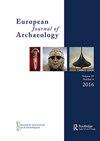作为一种挑战的战士:暴力、岩石艺术和北欧青铜时代社会凝聚力的保存
IF 1.4
2区 历史学
0 ARCHAEOLOGY
引用次数: 1
摘要
在青铜时代,战士可能是最著名的社会阶层。战争和其他暴力冲突的证据将他们与侵略和流血联系起来,而这些可以转化为社会地位。这使得战士对其社区的社会凝聚力构成潜在的双重威胁:他们不仅有作为死亡代理人威胁社区完整性的风险,而且还可能挑战地方当局并引起内部冲突。在这里,作者提供的证据表明,内部冲突是北欧青铜时代社会的主要关注点,因为战士构成了内部社会挑战,并提出当地社区可能通过献祭武器和通过岩石艺术构建社会叙事等仪式来减轻这种威胁。本文章由计算机程序翻译,如有差异,请以英文原文为准。
Warriors as a Challenge: Violence, Rock Art, and the Preservation of Social Cohesion During the Nordic Bronze Age
In the Bronze Age, warriors are probably the best-known social class. Evidence for warfare and other violent encounters links them to aggression and bloodshed that could be translated into social status. This made warriors a potential two-fold threat to the social cohesion of their communities: not only did they risk threatening the integrity of communities as agents of death but also they could challenge local authority and cause internal conflict. Here, the author presents evidence that suggests that internal conflict was a major concern for Nordic Bronze Age societies, in that warriors constituted an internal social challenge, and proposes that local communities may have mitigated this threat in rituals such as the sacrifice of weapons and the construction of social narratives through rock art.
求助全文
通过发布文献求助,成功后即可免费获取论文全文。
去求助
来源期刊

European Journal of Archaeology
ARCHAEOLOGY-
CiteScore
3.40
自引率
6.70%
发文量
58
期刊介绍:
The publication organ of the European Association of Archaeologists, the European Journal of Archaeology seeks to promote open debate amongst archaeologists committed to a new idea of Europe in which there is more communication across national frontiers and more interest in interpretation. The journal accepts not only new empirical data and new interpretations of the past but also encourages debate about the role archaeology plays in society, how it should be organized in a changing Europe, and the ethics of archaeological practice. All periods are covered; papers, review articles, interviews and short "debate" pieces are all sought. Whilst English is the primary language of publication in the EJA, papers submitted in French or German will be given equal consideration.
 求助内容:
求助内容: 应助结果提醒方式:
应助结果提醒方式:


